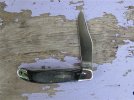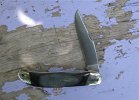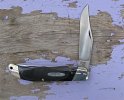bertl
Gold Member
- Joined
- Feb 17, 2011
- Messages
- 2,537
I've been going over this with some of the 300 experts from the Buck Forum but I think I need some Camillus expert comments. In 1972, Buck introduced the Model 317 Trail Blazer. The 317 was made by Camillus under contract with Buck. Buck never produced this model. Maybe it isn't a coincidence that this was the same year the Camillus Model 26 appeared in the Camillus catalog.
Throughout its production (1972-1989), there was very little change in the 317 Trail Blazer. From 1972 through 1974, the tang stamp was "Buck/Made in USA" with "317" on the pile side. After that (1974-1989) the tang stamp read "Buck/317/USA". What I am interested in is the characteristic of the Buck 317 nail nick. That is about the only thing that seems to have changed over the years. None of the 317 Trail Blazers had any sort of date stamp.
My hope (pipe dream) is that the nail nick might help date knives as early or late made from 1974 through 1989.
In addition to my knives, I have looked at about 100 photos of the 317 and found three different patterns for the nail nick. These patterns are based on three things; two of them are the position of the nick and the third is the character of the nick.
The knives produced from 1972-1974 with the tang stamp "Buck/Made in USA" show one example: the nick is Forward on the blade, Close to the spine and Thin (look at the Photo 1.).
For the knives with the tang stamp "Buck/317/USA" the nick is set farther Back from the end of the blade. Some of these have the nick Close to the spine and some have more space between the nick and the spine. I call this position Away. Some have a Thin nick and some have a Heavy nick. Photo 2 shows a knife with a Back, Close and Thin nick. Photo 3 shows a knife with a Back, Away and Heavy nick.
Of course, just to complicate things, I found photos of two knives with the "Buck/317/USA" tang stamp with a Forward, Away, and Heavy combination. I don't know what to make of that.
My questions are:
1. Did Camillus originally make the nicks by hand (Thin) and at some time switch to making them by machine (Heavy)?
2. Does anyone know why the nick was moved Back?
3. Do you think there might be a pattern over time to the nick variations or are they random?
Any comment will be appreciated.
Bert



Throughout its production (1972-1989), there was very little change in the 317 Trail Blazer. From 1972 through 1974, the tang stamp was "Buck/Made in USA" with "317" on the pile side. After that (1974-1989) the tang stamp read "Buck/317/USA". What I am interested in is the characteristic of the Buck 317 nail nick. That is about the only thing that seems to have changed over the years. None of the 317 Trail Blazers had any sort of date stamp.
My hope (pipe dream) is that the nail nick might help date knives as early or late made from 1974 through 1989.
In addition to my knives, I have looked at about 100 photos of the 317 and found three different patterns for the nail nick. These patterns are based on three things; two of them are the position of the nick and the third is the character of the nick.
The knives produced from 1972-1974 with the tang stamp "Buck/Made in USA" show one example: the nick is Forward on the blade, Close to the spine and Thin (look at the Photo 1.).
For the knives with the tang stamp "Buck/317/USA" the nick is set farther Back from the end of the blade. Some of these have the nick Close to the spine and some have more space between the nick and the spine. I call this position Away. Some have a Thin nick and some have a Heavy nick. Photo 2 shows a knife with a Back, Close and Thin nick. Photo 3 shows a knife with a Back, Away and Heavy nick.
Of course, just to complicate things, I found photos of two knives with the "Buck/317/USA" tang stamp with a Forward, Away, and Heavy combination. I don't know what to make of that.
My questions are:
1. Did Camillus originally make the nicks by hand (Thin) and at some time switch to making them by machine (Heavy)?
2. Does anyone know why the nick was moved Back?
3. Do you think there might be a pattern over time to the nick variations or are they random?
Any comment will be appreciated.
Bert



